2016 NISSAN LEAF brake system
[x] Cancel search: brake systemPage 18 of 437

Warn-ing
light Name
Page
12-volt battery charge
warning light 2-13
Anti-lock Braking Sys-
tem (ABS) warning light2-14
Approaching Vehicle
Sound for Pedestrians
(VSP) system warning
light2-14
BRAKE system warning
light (yellow)
2-14
BRAKE warning light
(red)2-15
Electric shift control sys-
tem warning light2-16
Warn-
ing
light Name
Page
EV system warning light 2-16
Headlight warning light 2-16
Low battery charge
warning light 2-16
Low tire pressure warn-
ing light2-16
Master warning light
(red/yellow)2-18
Power steering warning
light2-18
Seat belt warning light 2-18
Warn-
ing
light Name
Page
Supplemental air bag
warning light 2-19
Indica-
tor
light Name
Page
ECO mode switch indi-
cator light 2-19
Exterior light indicator
light2-19
Front fog light indicator
light (if so equipped)2-19
Front passenger air bag
status light2-19
High beam indicator
light (blue)2-19
WARNING AND INDICATOR LIGHTS
Illustrated table of contents0-11
Page 21 of 437

The LEAF is an electric vehicle. Some of the
vehicle’s systems operate differently and have
different operating characteristics than vehicles
equipped with an internal combustion engine. It is
important to carefully review the entire Owner’s
Manual for this reason. The main difference is the
LEAF is powered by electricity. The LEAF does
not require and it is not capable of using gasoline
like a vehicle powered by a traditional internal
combustion engine. The LEAF uses electricity
stored in the lithium ion (Li-ion) battery. The vehi-
cle’s Li-ion battery must be charged with electric-
ity before the vehicle can be driven. As the vehicle
operates, the Li-ion battery gradually discharges.
If the Li-ion battery becomes completely dis-
charged, the vehicle will not operate until it is
re-charged.
This vehicle uses two types of batteries. One is
the 12-volt battery that is the same as the battery
in vehicles powered by gasoline engines, the
other is the Li-ion battery (high voltage) .
The 12-volt battery provides power to the vehicle
systems and features such as the audio system,
supplemental restraint systems, headlights and
windshield wipers.The Li-ion battery provides power to the electric
motor (traction motor) that moves the vehicle.
The Li-ion battery also charges the 12-volt bat-
tery.
The vehicle must be plugged in for the Li-ion
battery to be charged. Additionally, the vehicle
system can extend the vehicle range by convert-
ing driving force into electricity that is stored in
the Li-ion battery while the vehicle is decelerating
or being driven downhill. This is called regenera-
tive brake. This vehicle is considered to be an
environmentally friendly vehicle because it does
not emit exhaust gases, such as carbon dioxide
and nitrogen oxide.
WARNING
Your vehicle contains a sealed Li-ion high
voltage battery. If the Li-ion battery is
disposed of improperly, there is a risk of
severe burns and electrical shock that
may result in serious injury or death and
there is also a risk of environmental dam-
age.
CAUTION
To prevent damage to the Li-ion battery:
• Do not expose a vehicle to extreme ambient temperatures for extended
periods.
• Do not store a vehicle in temperatures below −13°F (−25°C) for more than
seven days.
• Do not leave your vehicle for more than 14 days where the Li-ion battery avail-
able charge gauge reaches a zero or
near zero (state of charge) .
• Do not use the Li-ion battery for any other purpose.
THE EV (ELECTRIC VEHICLE)
SYSTEM LI-ION BATTERY
EV-2EV Overview
Page 27 of 437
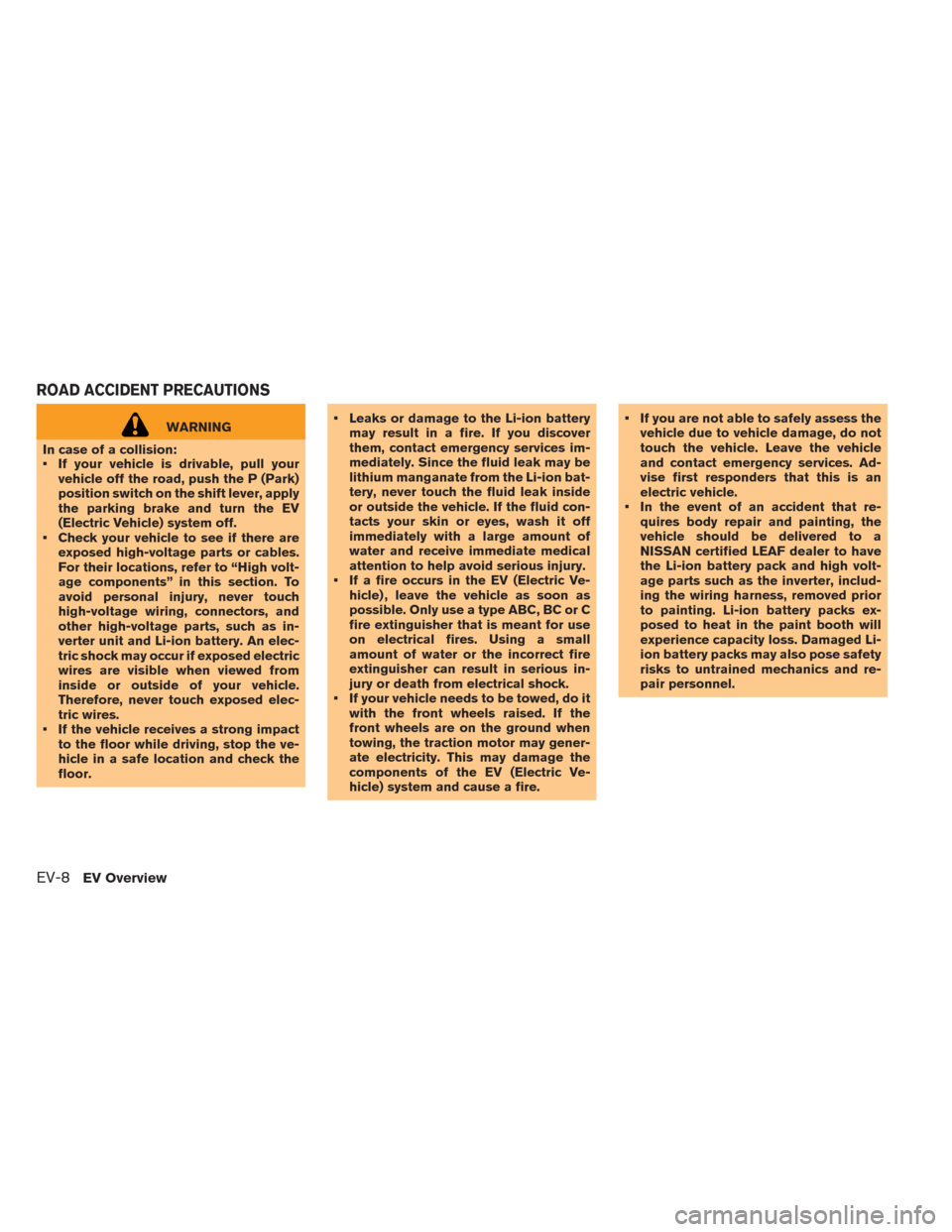
WARNING
In case of a collision:
• If your vehicle is drivable, pull your vehicle off the road, push the P (Park)
position switch on the shift lever, apply
the parking brake and turn the EV
(Electric Vehicle) system off.
• Check your vehicle to see if there are exposed high-voltage parts or cables.
For their locations, refer to “High volt-
age components” in this section. To
avoid personal injury, never touch
high-voltage wiring, connectors, and
other high-voltage parts, such as in-
verter unit and Li-ion battery. An elec-
tric shock may occur if exposed electric
wires are visible when viewed from
inside or outside of your vehicle.
Therefore, never touch exposed elec-
tric wires.
• If the vehicle receives a strong impact to the floor while driving, stop the ve-
hicle in a safe location and check the
floor. • Leaks or damage to the Li-ion battery
may result in a fire. If you discover
them, contact emergency services im-
mediately. Since the fluid leak may be
lithium manganate from the Li-ion bat-
tery, never touch the fluid leak inside
or outside the vehicle. If the fluid con-
tacts your skin or eyes, wash it off
immediately with a large amount of
water and receive immediate medical
attention to help avoid serious injury.
• If a fire occurs in the EV (Electric Ve- hicle) , leave the vehicle as soon as
possible. Only use a type ABC, BC or C
fire extinguisher that is meant for use
on electrical fires. Using a small
amount of water or the incorrect fire
extinguisher can result in serious in-
jury or death from electrical shock.
• If your vehicle needs to be towed, do it with the front wheels raised. If the
front wheels are on the ground when
towing, the traction motor may gener-
ate electricity. This may damage the
components of the EV (Electric Ve-
hicle) system and cause a fire. • If you are not able to safely assess the
vehicle due to vehicle damage, do not
touch the vehicle. Leave the vehicle
and contact emergency services. Ad-
vise first responders that this is an
electric vehicle.
• In the event of an accident that re- quires body repair and painting, the
vehicle should be delivered to a
NISSAN certified LEAF dealer to have
the Li-ion battery pack and high volt-
age parts such as the inverter, includ-
ing the wiring harness, removed prior
to painting. Li-ion battery packs ex-
posed to heat in the paint booth will
experience capacity loss. Damaged Li-
ion battery packs may also pose safety
risks to untrained mechanics and re-
pair personnel.
ROAD ACCIDENT PRECAUTIONS
EV-8EV Overview
Page 28 of 437
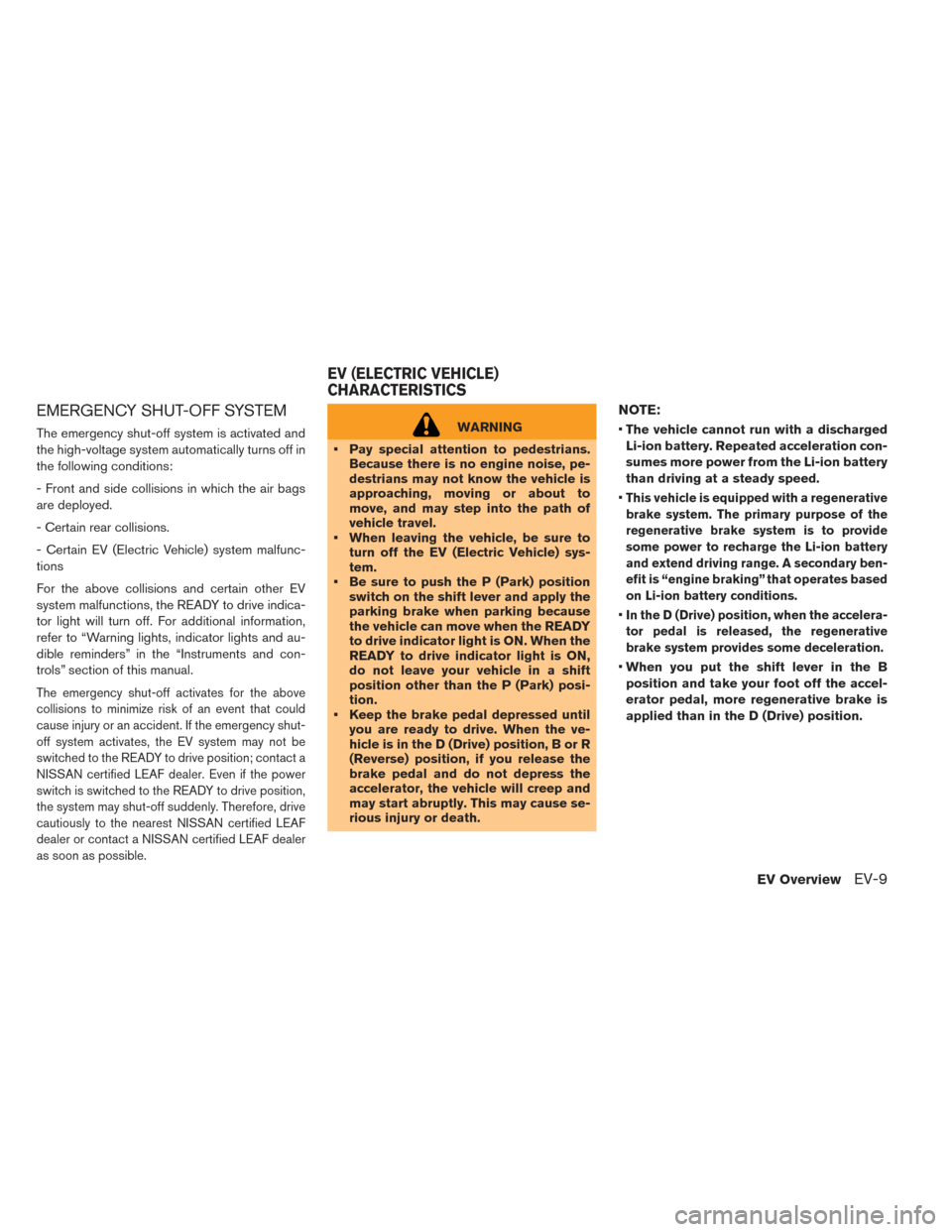
EMERGENCY SHUT-OFF SYSTEM
The emergency shut-off system is activated and
the high-voltage system automatically turns off in
the following conditions:
- Front and side collisions in which the air bags
are deployed.
- Certain rear collisions.
- Certain EV (Electric Vehicle) system malfunc-
tions
For the above collisions and certain other EV
system malfunctions, the READY to drive indica-
tor light will turn off. For additional information,
refer to “Warning lights, indicator lights and au-
dible reminders” in the “Instruments and con-
trols” section of this manual.
The emergency shut-off activates for the above
collisions to minimize risk of an event that could
cause injury or an accident. If the emergency shut-
off system activates, the EV system may not be
switched to the READY to drive position; contact a
NISSAN certified LEAF dealer. Even if the power
switch is switched to the READY to drive position,
the system may shut-off suddenly. Therefore, drive
cautiously to the nearest NISSAN certified LEAF
dealer or contact a NISSAN certified LEAF dealer
as soon as possible.
WARNING
• Pay special attention to pedestrians. Because there is no engine noise, pe-
destrians may not know the vehicle is
approaching, moving or about to
move, and may step into the path of
vehicle travel.
• When leaving the vehicle, be sure to turn off the EV (Electric Vehicle) sys-
tem.
• Be sure to push the P (Park) position switch on the shift lever and apply the
parking brake when parking because
the vehicle can move when the READY
to drive indicator light is ON. When the
READY to drive indicator light is ON,
do not leave your vehicle in a shift
position other than the P (Park) posi-
tion.
• Keep the brake pedal depressed until you are ready to drive. When the ve-
hicle is in the D (Drive) position, B or R
(Reverse) position, if you release the
brake pedal and do not depress the
accelerator, the vehicle will creep and
may start abruptly. This may cause se-
rious injury or death.
NOTE:
•The vehicle cannot run with a discharged
Li-ion battery. Repeated acceleration con-
sumes more power from the Li-ion battery
than driving at a steady speed.
•
This vehicle is equipped with a regenerative
brake system. The primary purpose of the
regenerative brake system is to provide
some power to recharge the Li-ion battery
and extend driving range. A secondary ben-
efit is “engine braking” that operates based
on Li-ion battery conditions.
•In the D (Drive) position, when the accelera-
tor pedal is released, the regenerative
brake system provides some deceleration.
• When you put the shift lever in the B
position and take your foot off the accel-
erator pedal, more regenerative brake is
applied than in the D (Drive) position.
EV (ELECTRIC VEHICLE)
CHARACTERISTICS
EV OverviewEV-9
Page 29 of 437

•Less deceleration is provided by the re-
generative brake system when the Li-ion
battery is fully charged. The regenerative
brake is automatically reduced when the
Li-ion battery is fully charged to prevent
the Li-ion battery from becoming over-
charged. The regenerative brake is also
automatically reduced when the battery
temperature is high/low (indicated by the
red/blue zones on the Li-ion battery tem-
perature gauge) to prevent Li-ion battery
damage.
• The brake pedal should be used to slow or
stop the vehicle depending on traffic or
road conditions. The vehicle brakes are
not affected by the regenerative brake
system operation.NOISE AND VIBRATION
You might experience the following noise or vi-
bration as a normal characteristic of this vehicle.
• Traction motor noise from the motor compartment.
• Water pump and radiator fan noise while charging.
• Compressor and radiator fan noise when the Climate Ctrl. Timer or remote climate control
(models with navigation system) is used.
• Relay operation noise and vibration at start-up and shut-down of the EV (Electric Vehicle) sys-
tem (power switch placed in the ON and OFF
position) .
• Approaching Vehicle Sound for Pedestrians (VSP) . This section provides a brief explanation for the
most important LEAF functions. For additional
information, refer to the specific sections of this
manual for detailed explanations of the vehicle
features and operation.
CHARGING THE LI-ION BATTERY
WARNING
The EV (Electric Vehicle) system uses a
high voltage current. Failure to follow the
proper handling instructions may cause
serious injury or death. Be sure to read
the “Charging” section and follow the
procedures and guidelines described.
LIFE WITH AN EV (SCENE GUIDE)
EV-10EV Overview
Page 36 of 437
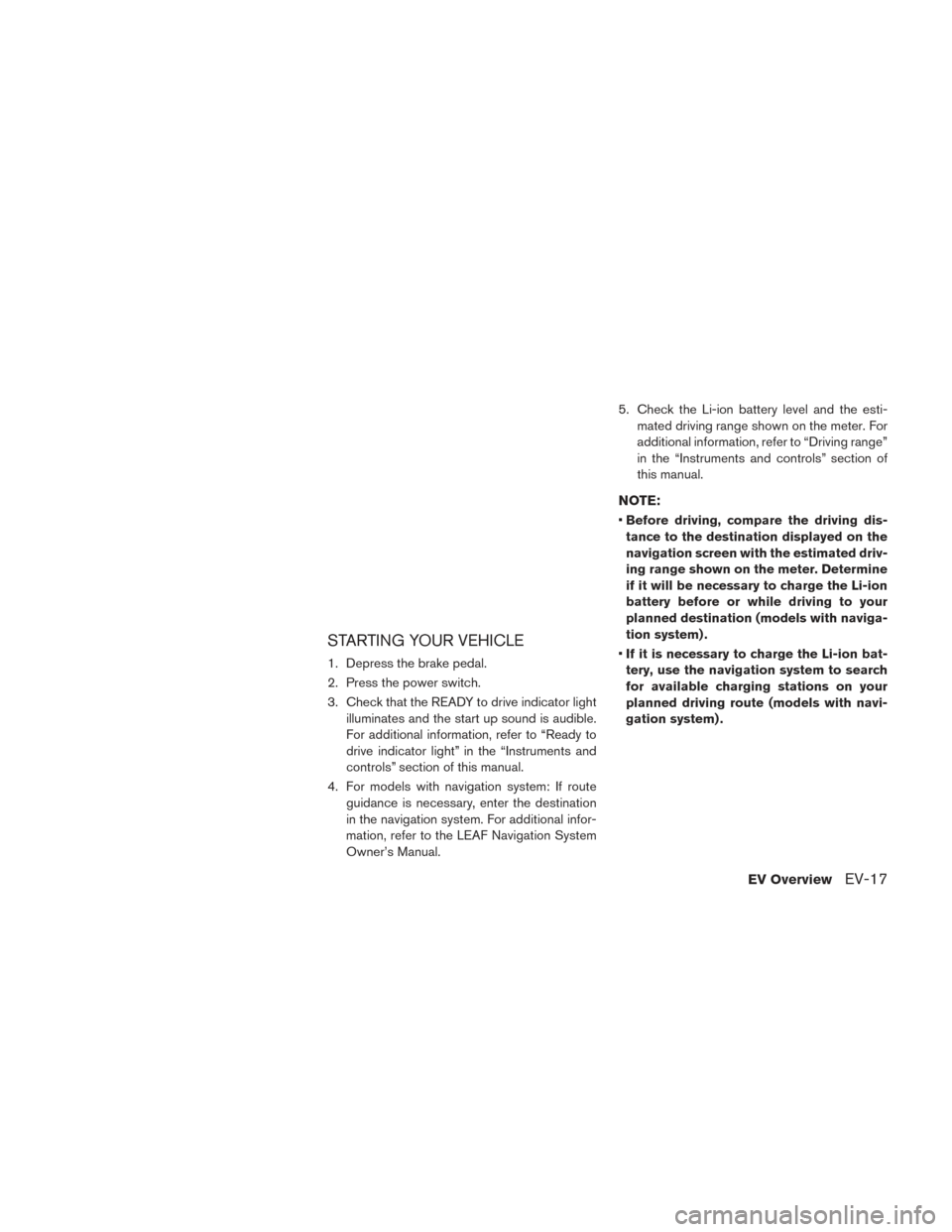
STARTING YOUR VEHICLE
1. Depress the brake pedal.
2. Press the power switch.
3. Check that the READY to drive indicator lightilluminates and the start up sound is audible.
For additional information, refer to “Ready to
drive indicator light” in the “Instruments and
controls” section of this manual.
4. For models with navigation system: If route guidance is necessary, enter the destination
in the navigation system. For additional infor-
mation, refer to the LEAF Navigation System
Owner’s Manual. 5. Check the Li-ion battery level and the esti-
mated driving range shown on the meter. For
additional information, refer to “Driving range”
in the “Instruments and controls” section of
this manual.
NOTE:
•Before driving, compare the driving dis-
tance to the destination displayed on the
navigation screen with the estimated driv-
ing range shown on the meter. Determine
if it will be necessary to charge the Li-ion
battery before or while driving to your
planned destination (models with naviga-
tion system) .
• If it is necessary to charge the Li-ion bat-
tery, use the navigation system to search
for available charging stations on your
planned driving route (models with navi-
gation system) .
EV OverviewEV-17
Page 43 of 437
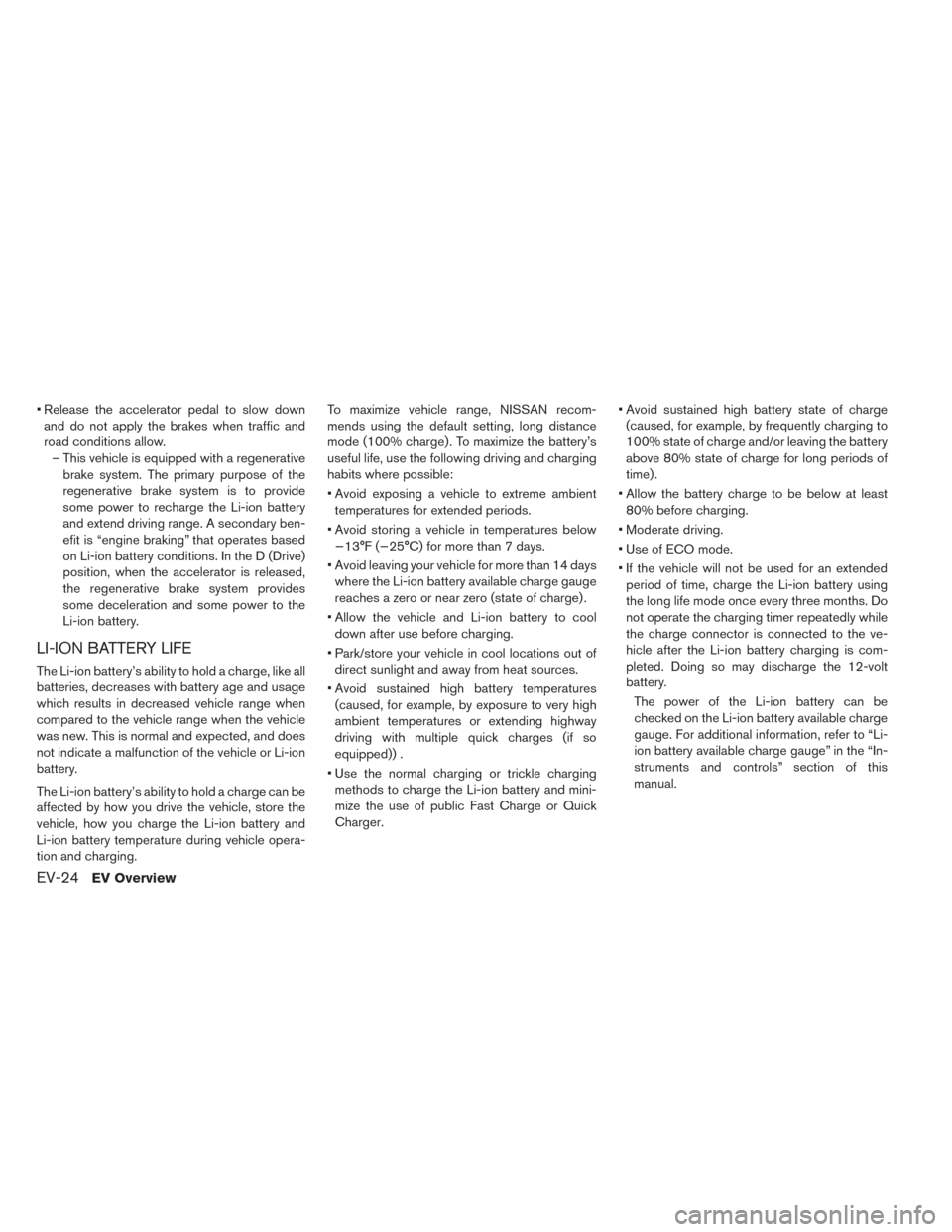
• Release the accelerator pedal to slow downand do not apply the brakes when traffic and
road conditions allow. – This vehicle is equipped with a regenerative brake system. The primary purpose of the
regenerative brake system is to provide
some power to recharge the Li-ion battery
and extend driving range. A secondary ben-
efit is “engine braking” that operates based
on Li-ion battery conditions. In the D (Drive)
position, when the accelerator is released,
the regenerative brake system provides
some deceleration and some power to the
Li-ion battery.
LI-ION BATTERY LIFE
The Li-ion battery’s ability to hold a charge, like all
batteries, decreases with battery age and usage
which results in decreased vehicle range when
compared to the vehicle range when the vehicle
was new. This is normal and expected, and does
not indicate a malfunction of the vehicle or Li-ion
battery.
The Li-ion battery’s ability to hold a charge can be
affected by how you drive the vehicle, store the
vehicle, how you charge the Li-ion battery and
Li-ion battery temperature during vehicle opera-
tion and charging. To maximize vehicle range, NISSAN recom-
mends using the default setting, long distance
mode (100% charge) . To maximize the battery’s
useful life, use the following driving and charging
habits where possible:
• Avoid exposing a vehicle to extreme ambient
temperatures for extended periods.
• Avoid storing a vehicle in temperatures below −13°F (−25°C) for more than 7 days.
• Avoid leaving your vehicle for more than 14 days where the Li-ion battery available charge gauge
reaches a zero or near zero (state of charge) .
• Allow the vehicle and Li-ion battery to cool down after use before charging.
• Park/store your vehicle in cool locations out of direct sunlight and away from heat sources.
• Avoid sustained high battery temperatures (caused, for example, by exposure to very high
ambient temperatures or extending highway
driving with multiple quick charges (if so
equipped)) .
• Use the normal charging or trickle charging methods to charge the Li-ion battery and mini-
mize the use of public Fast Charge or Quick
Charger. • Avoid sustained high battery state of charge
(caused, for example, by frequently charging to
100% state of charge and/or leaving the battery
above 80% state of charge for long periods of
time) .
• Allow the battery charge to be below at least 80% before charging.
• Moderate driving.
• Use of ECO mode.
• If the vehicle will not be used for an extended period of time, charge the Li-ion battery using
the long life mode once every three months. Do
not operate the charging timer repeatedly while
the charge connector is connected to the ve-
hicle after the Li-ion battery charging is com-
pleted. Doing so may discharge the 12-volt
battery.
The power of the Li-ion battery can be
checked on the Li-ion battery available charge
gauge. For additional information, refer to “Li-
ion battery available charge gauge” in the “In-
struments and controls” section of this
manual.
EV-24EV Overview
Page 47 of 437
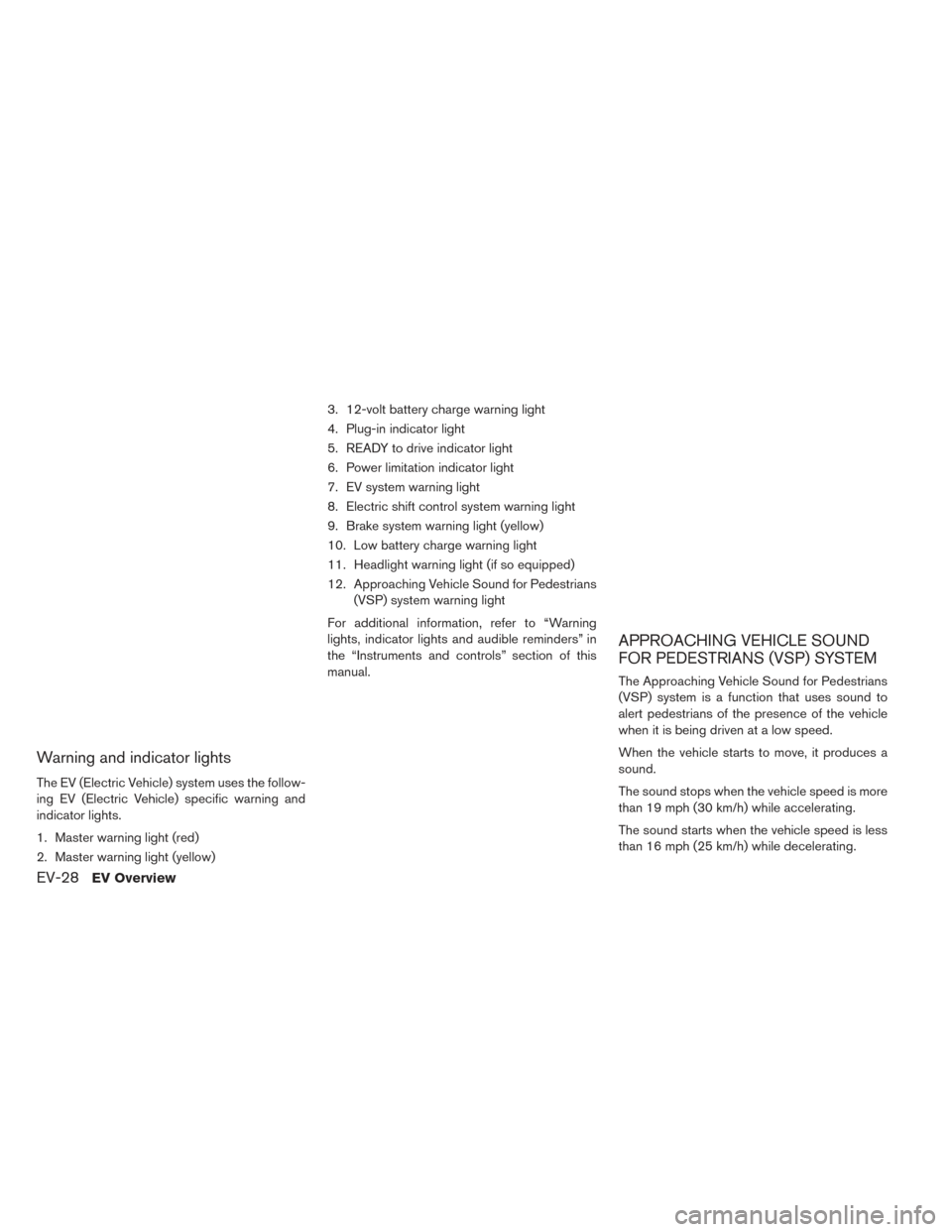
Warning and indicator lights
The EV (Electric Vehicle) system uses the follow-
ing EV (Electric Vehicle) specific warning and
indicator lights.
1. Master warning light (red)
2. Master warning light (yellow)3. 12-volt battery charge warning light
4. Plug-in indicator light
5. READY to drive indicator light
6. Power limitation indicator light
7. EV system warning light
8. Electric shift control system warning light
9. Brake system warning light (yellow)
10. Low battery charge warning light
11. Headlight warning light (if so equipped)
12. Approaching Vehicle Sound for Pedestrians
(VSP) system warning light
For additional information, refer to “Warning
lights, indicator lights and audible reminders” in
the “Instruments and controls” section of this
manual.
APPROACHING VEHICLE SOUND
FOR PEDESTRIANS (VSP) SYSTEM
The Approaching Vehicle Sound for Pedestrians
(VSP) system is a function that uses sound to
alert pedestrians of the presence of the vehicle
when it is being driven at a low speed.
When the vehicle starts to move, it produces a
sound.
The sound stops when the vehicle speed is more
than 19 mph (30 km/h) while accelerating.
The sound starts when the vehicle speed is less
than 16 mph (25 km/h) while decelerating.
EV-28EV Overview